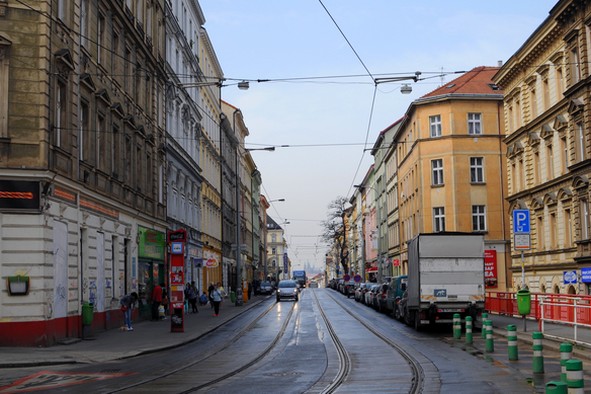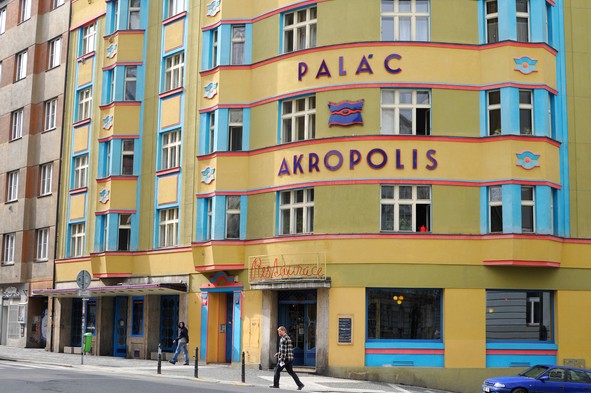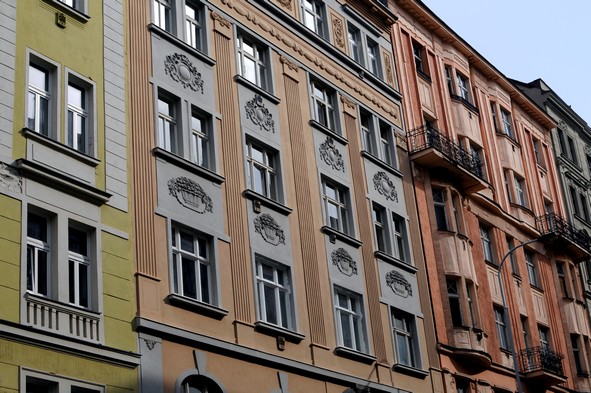Well off the beaten tourist track, Žižkov is Prague’s diamond in the rough. Formerly working class and a reputedly dodgy district, today it is a dynamic favourite with the city’s youth. Underground bars and a vibrant culture scene have cropped up all over Žižkov, perfectly befitting its hodgepodge of architectural styles and shabby charm. Long referred to as a ‘Free Republic’ by locals, a revolutionary and independent spirit remains palpable on the graffiti-laden streets of this unpretentious district.

Bustling Seifertova street at the heart of Žižkov (Photo: Maria Hagan)
I do a double take when I notice the small army of babies crawling up and down the Žižkov television tower like ants. Standing at the foot of the iconic steel structure and its jutting pod-like transmission rooms, I take in the no-frills, space-age design so at odds with the quaint Prague cityscape. Shooting out from between bourgeois homes it is rocket-like, ready for take-off. I think of the outrage locals felt when it was built on top of a Jewish cemetery under communist rule, rumoured to jam incoming Western TV and radio signals. And yet today locals speak about their outlandish landmark affectionately; the babies by renowned Czech artist David Černý a touch of dark humour thrown into the mix in the 1990s.
Wandering north into the depths of Žižkov away from Vinohrady, it is somewhat tatty in contrast with its prim neighbour. It strikes me that nothing feels quite stable in Žižkov where streets run steep, paintwork crumbles and the legacy of a revolutionary community lives on. As I wander around on a mild spring afternoon, I take in the charm of the area while savouring its imperfections, watching my step here and there as pretty pavement cobblestones, loose in their sockets, roll like dice underfoot. I smile as I remember the affectionate Czech name for the rounded stones kočičí hlavy: cat heads.

Stand-out live music venue Palac Ackropolis (Photo: Maria Hagan)
Reclaiming the Romanesque
Passing Prague’s mecca for live music, the Palác Akropolis, I meander down quiet residential streets looking up at the buildings that line them. Pastel tones are a favourite in Prague and give the buildings their picturesque charm. Žižkov is no exception with its cloudy yellows and peaches, its dusty mints and greens. But here, architecture is remarkably inconsistent, a hodgepodge of styles ranging from blocky modern housing estates and industrial expanses to extravagant Romanesque structures boasting statuettes and intricate stylings. Well-kempt, clean façades sit alongside blackened ones; walls shedding crumbling coats of paint reveal patches of the brickwork that lie beneath. In Žižkov, graffiti artists have reclaimed the walls as their own, giving even the best-kept buildings a going-over in spray paint.
I turn off quiet residential streets on to Seifertova, a bustling street at the heart of Žižkov. Old red and beige trams scuttle past, up and down the neighbourhood’s main arteries. It feels as though capitalism has given the place a miss, foregoing the smorgasbord of chain stores you might expect of an inner-city neighbourhood. Instead, a refreshing spattering of small local trades spill out on to the pavements in colourful stalls of fruit and flowers, most notably hole in the wall corner shops known as potraviny.
As I make my way down to the northern foot of Žižkov I get a strong sense of a district on the rise: ladders, scaffolding and construction workers hard at their labour, churning up earth and scaling facades.

Contemplating the roofs of Žižkov and the TV tower from Parukářka park (Photo: Maria Hagan)
Scaling the Hussite Hill
I reach the lowest point of the district when I hit the foot of Vítkov hill. Žižkov boasts many parks, and this is the most pleasant of all. Strolling along a path that gently coils up the hillside, I watch the flurry of dog walkers and runners enjoying the greenery at the heart of the city. The view steadily improves as I ascend, stretching far and wide over the old red-tiled roofs of Prague.
At the top stands a colossal National Monument built in 1938 in honour of Czechoslovak legionnaires – but used as a symbol of the communist regime after 1948. It is plain yet impressive in its stocky magnitude. At its west end, a colossal equestrian statue watches over the city: a lively horse with bulging eyes and jutting veins sporting its one-eyed master as though frozen en route to battle. Looking out over Prague, it pays tribute to Jan Žižka, the Hussite hero who defeated Holy Roman Emperor Sigismund on-site in 1420 and gave the district its name.

Detail of the doors of the National Monument at Vitkov Hill (Photo: Maria Hagan)
Busy Bar Stools
By the time I tear myself away from the view and wander back down into the streets it is evening and Žižkov has grown lively. Locals flock to the area in a search of a good time at the many bars that have earned Žižkov the reputation of being one of the best places for nightlife in the city. The district is home to a disproportionate number of watering holes relative to its populace and indeed I am spoiled for choice: wholesome and unpretentious pubs with wooden outdoor terraces fan out onto the streets, while discreet cocktail bars throb with chatter and cheer. Hidden behind unremarkable facades lie hangouts so unassuming you would hardly know they were there.
I hand a palmful of Czech koruna over the bar and feel like a local, sitting with a pivo amid the lively chatter. Expats, students, after-work drinkers, and older groups all frequent the bar stools here. Everyone seems to be happily disregarding the fact that it’s a Monday night and another working week has just begun. As it gets late, the bar grows busier and smokier. Well-accustomed to the ban on public smoking back home, I enjoy the smokiness in the moment. It feels like a step back through time. And though I know he lies in his grave in a cemetery nearby, I catch myself thinking that if Kafka himself were to stroll through the door right now, I’d be delightfully unsurprised.
It’s a world away from the loud touristy spots of the historical centre and a welcome change of pace. While Žižkov may not harbour a wealth of exceptional sights to see, true value emerges in its authenticity.

A palette pastels down the residential streets of the south (Photo: Maria Hagan)